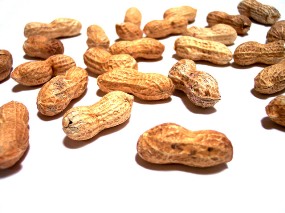Nut so good

A few weeks ago I received a question from one the Pig Progress readers. She asked me if she could feed her backyard potbellied pigs some leftover peanuts and peanut butter. My first reaction was: of course! Why not?
By©Emmy Koeleman
Peanuts are full of nutrients and peanuts skins – the leftovers from making peanut butter – are already often passed on to pig farmers for use in pig feed. However, some of the recent feed and food scares involving peanuts©made me a bit hesitant. Are peanuts nut so good then?
Peanuts don’t cover the needs
So I made myself delve a bit deeper into the use of peanuts in swine diets. When I did, I found a prehistoric paper (1938!) on a study where peanuts were fed to pigs. The author of the piece – Mr Kirk – from the University of Florida explained that the soil in many sections of the South East of the US is better adapted for growing peanuts than for other swine-fattening crops.
However, the pigs kept in these peanut fields (back then quite normal I guess?) seemed to have a lot of problems with their bones: they were weak, thin walled and sometimes even fractured (so no happy running around in the peanut field!).
According to Kirk, this is a clear sign of mineral deficiencies in the diet and concluded that feeding pigs alone on peanuts is not recommended. The pigs fed peanut, salt and calcium carbonate had strong bones which showed no indication of weakness. I find it pretty logical that pigs would encounter some sort of nutritional problems when they only eat peanuts, but in 1938 pig farming was of course slightly different organised as nowadays.
Effect on sow lactation
A more recent paper (Journal of Animal Science (1990)) looked at the effect of roasted or raw peanut kernels on lactation performance and milk composition of swine. A lactation trial involving 105 sows was conducted to determine the effect of 12% roasted or raw, ground, whole, shelled peanuts on sow weight change during lactation, feed intake, piglet and litter weight gain, milk composition, and days to return to post weaning oestrus. Diets contained either 5% animal fat or equivalent added fat from 12% roasted or raw, ground, shelled peanuts.
It was shown that the replacement of animal fat by roasted or raw peanuts had no effect on sow weight change, average daily feed intake during lactation or days to oestrus post-weaning, or on piglet weight gain or survival. Milk composition (percentage fat and protein) was not altered by source of fat in the summer; however, in the winter, sows fed roasted peanuts had higher milk fat and protein percentage post farrowing than other treatment groups. The paper did not fully describe how the peanuts positively influenced the milk composition.
Softer carcass fat
The search goes on… A paper published in a 1992 edition of the Journal of Animal Science describes a study in which a high-oleic-acid peanut breeding line was used to determine the effects on carcass fat. Forty-eight pigs were allotted to four treatments that consisted of corn-soybean meal diets that contained:
1. High-oleic peanuts (HOP),
2. Regular commercial peanuts (RP), or
3. Canola oil (CO), each added at a dietary level to provide 10% added fat/oil, and
4. A control diet with no added fat/oil.
The study showed that all three dietary oil sources resulted in increases of mono-unsaturates in the backfat; the HOP diet resulted in the greatest increase (32% greater than control). Carcass fat was softer/oilier from pigs fed CO and RP diets, but not from those fed HOP diets, compared to the control diet.
Testing is crucial
To wrap up this short peanut review, I can conclude that there are some good and some downsides to peanuts. Peanuts can be a wolf in sheep’s clothing, especially when you talk about mycotoxins and in particular aflatoxins! But, modern screening techniques are there to help.
According to the National Peanut Research Lab in the US, aflatoxin control in peanuts can be done by controlling peanut kernel moisture, early harvesting, and use of newly developed biological control technology. Commercial use of the bio-control technology has been shown to prevent 85% of preharvest aflatoxin contamination with reductions in shelled peanuts of up to 98%. The good side of using peanuts is their availability (as by product from the peanut butter factories).
Price wise, it could therefore be a good option to use this by-product (in this case the peanut shells). Nevertheless, be careful when you consider mixing peanuts in swine feeds. Just make sure you send a sample to a testing laboratory.











